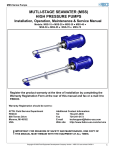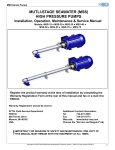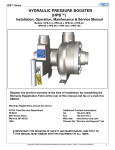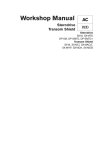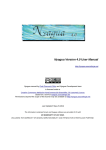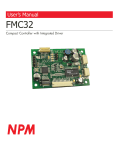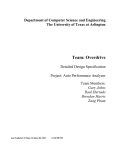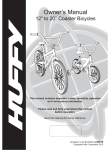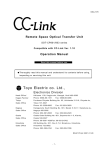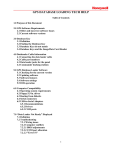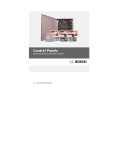Download MSB_15-120_Service_Manual
Transcript
MSB Series Pumps MUTLI-STAGE BRACKISH (MSB) LOW PRESSURE PUMPS Installation, Operation, Maintenance & Service Manual Models: MSB-15 ● MSB-20 ● MSB-30 ● MSB-40 ● MSB-55 ● MSB-75 ● MSB-90 ● MSB-120 Register the product warranty at the time of installation by completing the Warranty Registration Form at the rear of this manual and fax or e-mail it to FEDCO. Warranty Registration should be sent to: ATTN: Field Service Department Additional Contact Information: FEDCOTel734-241-3935 800 Ternes DriveFax734-241-5173 Monroe, MI 48162 Web site: www.fedco-usa.com USAChoose the "Service and Support" tab ! IMPORTANT: FOR REASONS OF SAFETY AND MAINTENANCE, ONE COPY OF THIS MANUAL MUST REMAIN WITH THE EQUIPMENT AT ALL TIMES. Copyright © 2009 Fluid Equipment Development Company Version – MSB 1.1 Last revised: 04/2012 1 MSB Series Pumps Table of Contents Theory and Operation ............................... ....... 3 Basic Troubleshooting ............................. 27 MSB Pump External Components ................. 3 Visual Inspection ................................... 27 Troubleshooting Chart .......................... 28 MSB Pump Internal Components .................. 4 Installation Procedures ..................................... 5 Shaft Seal Replacement ......................... 29 Warnings and Safety Precautions ....... .......... 5 Balance Disc Replacement .................... 35 User Health and Safety .................................. 6 Specifications .......................................... 43 In The Work Area ........................................... 6 Components Exploded Views .............. 43 Electrical Connections and Regulations ..... ... 6 Recommended Spare Parts List .......... 44 Variable Frequency Drive (VFD) Service Parts Kits ................................. 44 Requirements .............................................. 7 Ordering Parts ..................................... 45 Inspection of Unit upon Receipt ..................... 7 Fastener Specifications ....................... 46 Pump Storage Requirements ......................... 7 Balance Disc Specifications ................ 46 Motor Storage Requirements ......................... 7 Lubricants and Compounds ................. 46 Pre-Installation ............................................... 7 Maintenance ........................................ 47 Lifting and Handling ....................................... 9 Service Policy .......................................... 48 Optional Baseplate Installation ..................... 11 Return Authorization Number (RAN ..... 48 Foundation Specifications ..............................11 Warranty ........................................ ...... 49 Motor Installation ............................................12 Warranty Registration Form ........ ........ 50 Start Up Record ............................... .... 51 Flexible Coupling Check ............................... 13 Initial Pump Alignment ..................................... 16 Overhaul Record .................................. 52 Final Pump Alignment ................................... 20 Pump Piping Connections ............................. 24 Recommended Instrumentation and Operation ............................................ 25 Upstream Filtration ........................................ 26 Preparation for Pump Start Up ........................ 26 Start Up Precautions ....................................... 26 Start Up Check List ...................................... 26 Pump Start Up ........................................... ... 26 2 Copyright © 2009 Fluid Equipment Development Company Version – MSB 1.1 Last revised: 04/2012 MSB Series Pumps Theory and Operation MSB Pump External Components Multi-stage brackish (MSB) pumps are centrifugal feed pumps specifically designed to supply high pressure pumps for brackish water reverse osmosis (BWRO) service. MSB pumps develop pressure by using a series of impellers mounted on a rotating shaft. Rotating this fluid through centrifugal force develops a pressure higher than was input. Pressure can be increased through the addition of impeller stages or by increasing shaft rpm. Motors are selected according to equipment operating requirements (Figure 1). A flexible coupling allows the pump shaft to float within the coupling eliminating thrust against the motor. The inlet and discharge housing is designed to connect to grooved rigid piping with couplings. The inlet housing itself can be attached to the pump in four different positions 90°apart. A precision leveling foot supports the end shell housing and is fully adjustable to allow accurate pump-to-motor shaft alignment. Typical MSB-15/MSB-120 Pump External Components 3 1 2 4 5 6 7 8 Item Description Item Description 1 Motor 5 Top cradle 2 Motor adapter 6 Discharge housing 3 Inlet Housing 7 Precision leveling foot 4 End shell housing 8 Flexible coupling (inside of Motor Adapter Figure 1 MSB Pump External Components Copyright © 2009 Fluid Equipment Development Company Version – MSB 1.1 Last revised: 04/2012 3 MSB Series Pumps Theory and Operation (cont.) MSB Pump Internal Components The internal components of an MSB pump consist of a number of stages. The basic components contained in a single stage consist of an impeller and a diffuser with a split cone and bushing which prevent friction and wear. Behind the discharge housing at the end of the pump is the WATER BEARING™ assembly. (Figure 2). The balance disc rides in the bearing carrier and serves as a thrust bearing for the pump. This unique design uses patented WATER BEARING™ technology which allows feed water to cool and lubricate the balance disc. INLET PRESSURE SINGLE STAGE As the motor rotates the pump, pressure differences acting on the rotating impellers generate an axial thrust acting toward the motor. The water bearing employs the balance disc to create a counter-pressure which exactly cancels the impeller thrust load. The internal throttle nipple is used help produce the counter-pressure on the balance disc. This thrust and counter-thrust allows the disc to "self-balance" based on operating conditions. WATER BEARING™ ASSEMBLY DISCHARGE PRESSURE Figure 2 MSB Pump Internal Flow 4 Copyright © 2009 Fluid Equipment Development Company Version – MSB 1.1 Last revised: 04/2012 MSB Series Pumps Installation Procedures Warnings and Safety Precautions Safety practices and precautions for the operation and maintenance of all FEDCO pump products MUST BE FOLLOWED. This information supplements oral or written instructions that may be received. Safety MUST be practiced as part of the standard operating procedures for this equipment during any installation and operation. To ensure that safe operating and maintenance procedures are followed, operators should develop and keep up a program of safety checks and current instructions. This manual contains certain operating and maintenance procedures that involve exposure to potentially hazardous situations. The levels of hazardous situations are as follows: DANGER Hazards which are IMMEDIATELY ACCESSIBLE, and capable of causing SEVERE PERSONAL INJURY OR DEATH. WARNING Hazards which are NOT IMMEDIATELY ACCESSIBLE, but are capable of causing SEVERE PERSONAL INJURY OR DEATH. CAUTION Hazards which are NOT IMMEDIATELY ACCESSIBLE, and can cause PERSONAL INJURY. ELECTRICAL HAZARD Hazards which are related to Electrical Components and can RESULT IN ELECTRICAL RISKS, SHOCK, ELECTROCUTION OR DEATH if instructions are not followed properly. PUNCTURE HAZARD Hazards which are NOT IMMEDIATELY ACCESSIBLE and can RESULT IN SEVERE PERSONAL INJURY OR DEATH if instructions are not followed properly. Copyright © 2009 Fluid Equipment Development Company Version – MSB 1.1 Last revised: 04/2012 5 MSB Series Pumps Installation Procedures (cont.) WARNING ELECTRICAL HAZARD All pump and safety precautions must be followed to prevent physical injury to the operator. It is illegal to operate the equipment in an EU member state, which requires CE compliance, if the manual is not written in that state’s language. If a translation is needed, please contact a FEDCO representative. Always follow the Lock-out / Tag-out procedure developed by your company before starting any maintenance or repair (Figure 3). CAUTION A pump is a pressure-generating device with rotating parts that can be hazardous. Any device containing generated pressure can rupture, explode or discharge its contents if it is sufficiently over-pressurized and may possibly result in personal injury, property damage, environmental damage and death. All necessary precautions must be exercised to insure over-pressurization does not occur. FEDCO will not accept responsibility for physical injury, damage or delays caused by a failure to observe the instructions in this manual. WARNING Installation, operation or maintenance of the pump unit in any manner which is not covered in this manual could cause damage to the equipment, serious injury or death. This includes any modification to the equipment or the use of parts not provided by FEDCO. If there is a question regarding the intended use of the equipment, please contact a FEDCO representative before proceeding. CAUTION This manual clearly identifies accepted methods for safe disassembly. These methods must be strictly adhered to. WARNING Do not use the pump equipment for a different application than originally specified without the approval of a FEDCO representative. WARNING NEVER operate the pump equipment: ● below the minimum flow rate. ● when dry. ● without priming. ● without proper guards and safety devices installed. ● with the discharge valve closed. ● with the suction valve closed. 6 FRONT BACK Figure 3 Typical Lock-Out Tags User Health and Safety Safety Equipment should be used in accordance with company regulations. The following safety equipment should be used within the work area: • Helmet. • Safety Glasses with shields or goggles. • Safety Shoes. • Protective Gloves. • Hearing Protection is recommended. • Follow safe lifting methods to avoid personal injury. In the Work Area • Always keep the work area clean and dry. • Avoid all electrical dangers. Be aware of risks from electric shock or arc flash hazards. • Utilize adequate lifting equipment and methods. Electrical Connections and Regulations • Refer to the motor nameplate for specific electrical operating information (Figure 4). • Electrical connections must be made by certified electricians in compliance with all international, national, state, and local regulations and codes. • Insure the product is isolated from the power supply and cannot be accidentally energized. • Make sure all thermal contacts are connected to a protection circuit according to product specifications. • All electrical equipment must be properly grounded (Figure 5). • During installation, service and repair, must always follow your company’s Lock-out / Tag-out procedure. Copyright © 2009 Fluid Equipment Development Company Version – MSB 1.1 Last revised: 04/2012 MSB Series Pumps Installation Procedures (cont.) Variable Frequency Drive (VFD) Requirements A VFD must be used to optimize the system to the best efficiency point (BEP) of the RO system. The VFD must be configured to match the motor nameplate information. The VFD does not come pre-programed (Figure 4). Please contact the equipment supplier if the VFD programming manual is not available. Important note for CE compliant countries: the VFD must have a line filter which must be installed in the same metallic enclosure as the drive. VARIABLE FREQUENCY OUTPUT POWER SINE WAVE INPUT POWER HITAKHI FUNC 1 Hz POWER A ALARM RUN STOP/ RESET RUN PRG 2 STR W 200 CONTROL SIGNAL WARNING HAZARD OF PERSONAL INJURY OR ELECTRIC SHOCK Disconnect incomming power and wait ten minutes before opening front cover VARIABLE FREQUENCY DRIVE (VFD) Figure 4 Basic VFD Configuration Inspection of Unit Upon Receipt • • • Review the contents of the packing list to make sure all components have been included. Inspect all components for signs of damage which may have occurred during shipping. If damage is present or if the contents are incomplete, please contact your shipping company or a FEDCO representative before proceeding. Pump Storage Requirements The MSB unit must be protected from moisture, sand, grit, and other foreign matter. Do not remove the protective covers from the pipe connections until ready to install. For long-term storage, keep pump and all other components in its original crate away from moisture, sand, grit or dust. Motor Storage Requirements Specific conditions are required for proper motor care and storage. Refer to the motor manufacturers instructions for specific steps and instructions. Pre-Installation In most instances, the unit and motor are shipped pre-assembled. All necessary installation accessories will be included with the pump. Copyright © 2009 Fluid Equipment Development Company Version – MSB 1.1 Last revised: 04/2012 7 MSB Series Pumps Installation Procedures (cont.) 4 to 8 Motor adapter bolts with washers 4 to 6 Motor mounting bolts with washers and nuts (if motor and baseplate is provided by FEDCO) Feeler Guages 2 Alignment Pins Flexible coupling Pump shaft key E EIZ TI-S AN 2 Flexible coupling set screws Anit-seize compound Motor shaft key (if motor is provided by FEDCO) Figure 5 Installation Accessories 8 Copyright © 2009 Fluid Equipment Development Company Version – MSB 1.1 Last revised: 04/2012 MSB Series Pumps Installation Procedures (cont.) Lifting and Handling CAUTION Observe all lifting precautions. Failure to follow all lifting and handling precautions may result in serious injury! Unit weight is listed on the unit nameplate. Determine the weight of the unit to select an appropriate lifting method. If the weight of the pump exceeds manual lifting limits, mechanical lifting equipment must be used. MSB pumps can be lifted by the shell using approved lifting straps together with suitable lifting equipment. The straps must be installed around the shell to properly balance the load and minimize stress on the inlet and motor adapter connections (Figure 7). Pump Assembly Lifting NO Figure 6 Improper Lifting Strap Positioning YES Figure 7 Proper Lifting Strap Positioning Copyright © 2009 Fluid Equipment Development Company Version – MSB 1.1 Last revised: 04/2012 9 MSB Series Pumps Installation Procedures (cont.) CAUTION Whenever possible, each component should be lifted and moved separately for safety. Do not lift the pump up by the shaft. If the unit is lifted by the shaft, damage may occur. Lifting and handling of the motor must be performed according manufacturers instructions. Do not lift the pump and motor by the motor eyebolt (Figure 8). The eyebolt is used for lifting the motor only. Motor and Pump Assembly Lifting NO NO Figure 8 Improper Motor and Pump Lifting Points YES Figure 9 Proper Motor and Pump Lifting Points 10 Copyright © 2009 Fluid Equipment Development Company Version – MSB 1.1 Last revised: 04/2012 MSB Series Pumps Installation Procedures (cont.) Optional Baseplate Installation Some units include an optional FEDCO baseplate which provides good mounting surfaces for the motor and pump (Figure 10). It also increases accuracy during the alignment process. Although the baseplate is precisely manufactured, it requires a solid foundation such as a concrete pad or rigid steel substructure. If the optional baseplate is used, it must be installed first to avoid distortion which may occur due to uneven floors or substructure (Figure 13). If the pump is installed within a container, it must be mounted on a rigid steel substructure that will not distort under the weight of the equipment or from torque reaction forces during pump operation. 1 3 2 4 Item Descripttion Item Description 1 Motor mounting (4 to 6 depending on motor) 3 Precision leveling foot mounting 2 Support bracket mounting 4 Baseplate mounting feet Figure 10 Optional Baseplate Foundation Specifications A concrete foundation is recommended for all MSB pump installations. Concrete provides good support and good vibration absorption. The foundation should have a mass that is 50% more than the total weight of the equipment and its perimeter should extend at least 6 inches (15 cm) on each side from the pump and motor. Make sure the concrete is completely dry and level before installing any machinery. Make sure anchor bolts and shims are properly sized and installed in cases of uneven surfaces (Figure 11). OPTIONAL BASEPLATE LEVELING HOLES CONCRETE FOUNDATION PROPER SHIM PLACEMENT Figure 11 Proper Shimming Copyright © 2009 Fluid Equipment Development Company Version – MSB 1.1 Last revised: 04/2012 11 MSB Series Pumps Installation Procedures (cont.) Motor Installation 1. Clean the motor flange face with a clean cloth to remove any foreign matter, rust or protective coating and place the motor in its mounting position. (Figure 12). Figure 12 Placing Motor in Mounting Position 2. Install the motor mounting bolts and shims as necessary (Figure 13). Tighten to motor manufacturers specifications. NOTE: Make sure to install shims where necessary to prevent motor frame distortion resulting from "softfoot." Soft-foot is a condition were one of the motor frame feet are not in flat contact with the mounting base. If not properly shimmed when the bolt is tightened, the motor frame will distort. SOFT-FOOT NO PROPERLY SHIMMED YES Figure 13 Installing Motor Mounting Shims 12 Copyright © 2009 Fluid Equipment Development Company Version – MSB 1.1 Last revised: 04/2012 MSB Series Pumps Installation Procedures (cont.) Motor Rotational Direction Check 3. Prior to pump installation, energize the motor to determine the direction of rotation. The correct rotation is indicated by arrows on the pump motor adapter (Figure 14). If the rotation is incorrect, reverse the polarity of the motor wiring to change the direction of rotation. NOTE: Reversing polarity of the VFD power input wires will not change the motor rotational direction. Figure 14 Directional Arrows on Motor Adapter 4. If the motor rotational direction is correct, disconnect the power to the motor according to lock-out/tag-out procedures and complete all electrical connections according to local codes and regulations. 5. Loosen the eight (8) screws and remove the coupling guards (Figure 15). Figure 15 Removing Coupling Guards Flexible Coupling Check 6. Slide the flexible coupling over the motor shaft with the motor shaft key (Figure 16). NOTE: If the motor shaft key does not fit properly in the coupling keyway, lightly file the motor shaft key until a proper fit is obtained. Figure 16 Installing Flexible Coupling on Motor Shaft Copyright © 2009 Fluid Equipment Development Company Version – MSB 1.1 Last revised: 04/2012 13 MSB Series Pumps Installation Procedures (cont.) 7. Inspect the flexible coupling radial and axial fit. It should be tight with no visible radial movement and slide smoothly on and off the motor shaft (Figure 17). NO MOVEMENT NO MOVEMENT NO MOVEMENT NO MOVEMENT SMOOTH MOVEMENT Figure 17 Checking Flexible Coupling Fit on Motor Shaft 8. Slide the flexible coupling over the pump shaft with the pump shaft key (Figure 18). NOTE: The rounded end of the key must be placed in the rounded end of the keyway. Figure 18 Installing Flexible Coupling on Pump Shaft 14 Copyright © 2009 Fluid Equipment Development Company Version – MSB 1.1 Last revised: 04/2012 MSB Series Pumps Installation Procedures (cont.) 9. Inspect the flexible coupling radial and axial fit. It should have little or no movement and slightly looser than the motor shaft fit. It should also slide smoothly on and off the pump shaft (Figure 19). LITTLE OR NO MOVEMENT LITTLE OR NO MOVEMENT LITTLE OR NO MOVEMENT LITTLE OR NO MOVEMENT 10. Once proper flexible coupling fit on both shafts has been obtained, remove the flexible coupling and proceed with Initial Pump Alignment. SMOOTH MOVEMENT NOTE: Flexible coupling will not be needed until Final Pump Alignment procedure. Figure 19 Checking Flexible Coupling Fit on Pump Shaft Copyright © 2009 Fluid Equipment Development Company Version – MSB 1.1 Last revised: 04/2012 15 MSB Series Pumps Installation Procedures (cont.) 3 4 5 1 6 2 7 8 Item Description 1 Top cradle 2 Bottom cradle 3 Threaded rod 4 Jam nut 5 Top nut 6 Threaded rod nut 7 Adjustment nut 8 Jam nut 9 Leveling foot frame 9 Initial Pump Alignment Figure 20 Precision Leveling Foot Components 11. Remove the four (4) nuts and the top cradle from precision leveling foot (Figure 21). Figure 21 Removing Top Cradle 12. Install the alignment pins (provided) 180° apart into the motor face (Figure 22). 180° APART Figure 22 Alignment Pin Installation 16 Copyright © 2009 Fluid Equipment Development Company Version – MSB 1.1 Last revised: 04/2012 MSB Series Pumps Installation Procedures (cont.) 13. Carefully slide the pump onto alignment pins and as close to the motor face as possible (Figure 23). NOTE: Depending on the motor manufacturer, a small gap may or may not be visible between the motor face and the pump adapter Figure 23 Positioning Pump onto Alignment Pins FEELER GAGE 14. If a gap exists between the motor adapter and motor, use feeler gauges (provided) to measure the gap at 4 different points 90° apart (Figure 24). NOTE: In some instances, there may be no gap between the motor and motor adapter. MOTOR ADAPTER MOTOR FLANGE FACE Figure 24 Motor Adapter Gap Measurement Points Copyright © 2009 Fluid Equipment Development Company Version – MSB 1.1 Last revised: 04/2012 17 MSB Series Pumps Installation Procedures (cont.) 15. Align the pump by adjusting the precision leveling foot: A. ADJUST TOP AND BOTTOM GAP - by rotating the adjustment nuts (Figure 27). B. ADJUST RIGHT SIDE AND LEFT SIDE GAP by loosening the four (4) precision leveling foot mounting bolts and slightly moving precision leveling foot side-to-side (Figure 25). A A B B Figure 25 Precision Leveling Foot Adjustment 16. Measure the motor adapter gap and continue adjustment until the gap between the motor adapter and the motor is the same at the top and bottom (Figure 26). NOTE: This step is critical in properly aligning the pump with the motor. All four measurements must be the same to ensure proper pump-to-motor shaft alignment. NO A B YES A=B Figure 26 Proper Top and Bottom Gap 18 Copyright © 2009 Fluid Equipment Development Company Version – MSB 1.1 Last revised: 04/2012 MSB Series Pumps Installation Procedures (cont.) B A 17. Measure the motor adapter gap and continue adjustment until the gap between the motor adapter and the motor is the same on both sides (Figure 27). A≠B NO B A A=B YES Figure 27 Proper Side-to-Side Gap 18. Secure the precision leveling foot to foundation with four (4) bolts, washers and tighten to specification for the size bolts used (Figure 28). NOTE: Do not secure any other support brackets at this time. Figure 28 Securing Precision Leveling Foot Copyright © 2009 Fluid Equipment Development Company Version – MSB 1.1 Last revised: 04/2012 19 MSB Series Pumps Installation Procedures (cont.) 19. Carefully slide the pump away from the motor and proceed to the Final Pump Alignment procedure. NOTE: Make sure the pump is well supported and slide the pump far enough to provide sufficient room to install the flexible coupling (Figure 29). 30.5 cm (12”) Final Pump Alignment 20. Apply system compliant anti-seize compound into the motor shaft keyway and install the motor shaft key (Figure 30). Figure 29 Separating Pump from Motor APPLY SYSTEM COMPLIANT ANTI-SEIZE COMPOUND Figure 30 Installing Motor Shaft Key 21. Slide the flexible coupling onto the motor shaft until the end of the motor shaft is flush with the end of the motor half of the flexible coupling (Figure 31). NOTE: The motor shaft and its key should NOT be touching the plates of the flexible coupling disc pack. Ensure that the motor shaft key does not slide out of place or project past the end of the motor shaft. Figure 31 Positioning Flexible Coupling on Motor Shaft 20 Copyright © 2009 Fluid Equipment Development Company Version – MSB 1.1 Last revised: 04/2012 MSB Series Pumps Installation Procedures (cont.) 22. Install the two (2) set screws and tighten (Figure 32). NOTE: NO set screws should be installed on the pump shaft side of the coupling. Figure 32 Flexible Coupling Set Screw Locations APPLY SYSTEM COMPLIANT ANTI-SEIZE COMPOUND 23. Apply system compliant anti-seize compound into the pump shaft keyway and install the pump shaft key (Figure 33). NOTE: The rounded end of the key must be placed in the rounded end of the keyway. Figure 33 Pump Shaft Key Installation 24. Rotate both shafts until the pump shaft key and the flexible coupling keyway are on top and aligned (Figure 34). Figure 34 Aligning Pump Shaft Keyway Copyright © 2009 Fluid Equipment Development Company Version – MSB 1.1 Last revised: 04/2012 21 MSB Series Pumps Installation Procedures (cont.) 25. Carefully slide the pump against the motor making sure the pump shaft key slides smoothly into the flexible coupling. Push the pump by hand until the motor adapter and the motor are in contact (Figure 35). NOTE: Make sure the pump shaft key does not jam or fall out during installation. Figure 35 Position Pump for Final Alignment 26. Using feeler gauges, re-measure any gap between the motor adapter and motor at 4 different points 90° apart around the motor adapter (Figure 36). FEELER GAGE NOTE: In some instances, there may be no gap between the motor and motor adapter. Figure 36 Motor Adapter Gap Measurement Points 27. If uneven gaps exist, adjust the precision leveling foot as necessary until any gaps between motor and motor adapter are all equal (Figure 37). The gap variation should not exceed 0.381 mm (0.015”) around motor adapter. Figure 37 Precision Leveling Foot Adjustment 22 Copyright © 2009 Fluid Equipment Development Company Version – MSB 1.1 Last revised: 04/2012 MSB Series Pumps Installation Procedures (cont.) 28. Install the four (4) motor adapter bolts and washers (Figure 38) and tighten to 61 N-m (45 Lb-ft). Figure 38 Installing Inlet Housing Bolts 29. Install the top cradle onto the precision leveling foot and secure with the four (4) nuts (Figure 39). Tighten to 149 N-m (110 Lb-ft). Figure 39 Installing Top Cradle 30. Install the coupling guards and tighten the eight (8) screws (Figure 40). Figure 40 Coupling Guard Installation Copyright © 2009 Fluid Equipment Development Company Version – MSB 1.1 Last revised: 04/2012 23 MSB Series Pumps Installation Procedures (cont.) Pump Piping Connections Pipe Couplings • Use only grooved type couplings at all pump and pipe connections (Figure 42). • Follow all manufacturer installation and torque specifications. • Align all piping carefully before installing couplings. • DO NOT use couplings to force piping to align. Make sure all seals seat correctly inside the coupling. • If piping or seals are not aligned correctly, leaking may occur under pressure. Piping Alignment • Accurate alignment and support of all piping connected to the pump is critical (Figure 41). • Any movement occurring at the inlet or discharge pump connections may cause pump misalignment and stress over time. • Do not force any misaligned pipes to connect to the pump discharge or inlet. GROOVED COUPLING YES COUPLING SEAL NO Figure 42 Typical Grooved Coupling Figure 41 Proper Piping Alignment Inlet Piping Keep the inlet pipe free of high points which could trap air and could disrupt pump priming. Vacuum and/or pressure gages are recommended to allow measurement of pump inlet pressure. NEVER throttle the pump on the inlet side. Outlet Piping The pump discharge piping should have a removable section of pipe such as a spool piece or elbow to allow the pump to slide forward for service (Figure 43). Servicing the shaft seal, water bearing or flexible coupling requires a space of approximately 30.5 cm (12 inches) minimum. The pump assembly must be free to move away from the motor in order to gain access to these components. DISCHARGE HOUSING OUTLET PIPING 30.5 cm (12 in) MINIMUM REMOVABLE SECTION FOR PUMP SERVICE Figure 43 Removable Section for Pump Service 24 Copyright © 2009 Fluid Equipment Development Company Version – MSB 1.1 Last revised: 04/2012 MSB Series Pumps Installation Procedures (cont.) Recommended Instrumentation and Operation For safe pump operation, a pressure switch or relief valve is recommended for the high pressure side (before the membranes). Pressure gauges should be installed at the inlet and outlet of the MSB pump (Figure 44). If a throttle valve is used, an additional gauge is needed on the output side of the valve. It is recommended that a pressure switch should be installed at the pump inlet to prevent pump operation if the feed pressure to the pump is below specifications. MSB pumps are not equipped with a check valve to prevent back flow. Refer to the pump yellow tag and pump nameplate for equipment specifications (Figure 45). PRE-FILTRATION SYSTEM SOURCE INLET PG 1 P MSB PUMP PG 3 PG 4 PS 2 THROTTLE VALVE (IF USED) MEMBRANE Figure 44 Recommended Instrumentation YELLOW TAG FRONT 333 gpm 20 psi 587 psi 1.019 3,442 17 ft. www.fedco-usa.com MSB- XXXX Serial No: XXXX Feed Flow Inlet Pres Disc. Pres Feed SG (calc) RPM NPSHR Duty Point Version 2.3 B MSB - 9019 S/N 3671 B Max Temp (F): XXX RPM: XXXX Flow (gpm): XXX DP (psi): XXX Max rated Pressure (psi): XXX U.S. and International Patents Apply PUMP NAMEPLATE YELLOW TAG REAR Figure 45 Pump Operating Specifications Copyright © 2009 Fluid Equipment Development Company Version – MSB 1.1 Last revised: 04/2012 25 MSB Series Pumps Upstream Filtration Start Up Check List • An additional Start Up Check List is available in the rear of this manual. Also use the Start Up Record at the rear of this manual to record initial operating conditions at pump start up. • • The pump must be protected from debris in the feed water such as sand, gravel, or other particulate matter. A 20 micron filter must be installed upstream of the pump inlet to protect against foreign matter entering the system. Temporary strainers should be installed after initial start up or repairs to protect the pump from possible debris. Flexible coupling set screws tightened. Motor adapter guards installed. All anchor bolts tightened to specifications. Preparation for Pump Start Up Start Up Precautions All pipe couplings tightened to specifications. WARNING NEVER operate the pump equipment: ● below the minimum flow rate. ● when dry. ● without priming. ● without proper guards and safety devices installed. ● with the discharge valve closed. ● with the suction valve closed. ELECTRICAL HAZARD Refer to the motor name plate, electrical junction box cover, or wiring tag for proper wiring. All electrical connections should be made by a licensed electrician according to all local codes and regulations. Be sure to follow all manufacturer's instructions on motor lubrication. Ensure motor rotational direction is correct according to the arrow located on the motor adapter (Refer to “Motor Rotational Direction Check”). CAUTION Electric motors may develop continual noise over long periods. Proper ear protection should be worn during pump operation. Most noise will emanate from the electric motor. The noise level of the MSB pump is nominal and depends on its size and operating conditions. The typical level can range from 75dB to 97dB, measured at a distance of 1 meter (39 inches) around the pump. Sound may vary due to hydraulic resonance, valves and building walls. For applications were a minimum noise level is required, the system should be operated with the flow adjusted as close to optimum efficiency as possible. Motor rotational direction correct. Motor lubricated to manufacturers specifications. Final Pump Alignment performed. Inlet pressure indicator installed. Inlet pressure switch (if applicable) installed. Outlet pressure indicator installed. System pipes are clean and upstream filtration in place. System leak checked and all air vented from system. ALL safety devices in place. Pump Start Up NOTE: Use the “Start Up Record” located in the rear of this manual to record initial operating conditions at pump start up. 1. Activate the MSB pump and vent air from the system. 2. Verify that there are no leaks in the system. 3. Activate the MSS pump. 4. Inspect the system for leaks. NOTE: Some mechanical shaft seal leakage may occur for about 60 seconds after pump start-up. If the leakage continues longer than 60 seconds then proceed with the mechanical shaft seal replacement procedure. 5. Observe any unusual system noise or vibration. 6. If a vibration meter is available, record a baseline vibration reading at this time. 7. Adjust system valves and controls as needed to obtain the desired operating condition. 26 Copyright © 2009 Fluid Equipment Development Company Version – MSB 1.1 Last revised: 04/2012 MSB Series Pumps Basic Troubleshooting If the MSB pump does not operate properly, refer to the following troubleshooting charts as a guide to determining the concern and identifying the potential cause. If after consulting the troubleshooting charts the cause is still undefined, contact FEDCO technical support by e-mail (fedco-usa.com and choose the "Service and Support" tab), telephone or FAX. FEDCO will give you easy, step by step instructions on how to proceed. Visual Inspection • • • • • Make sure all items are accounted for on the start up check list. Inspect all piping and electrical connections to the motor and pump. Inspect the pump and motor mountings for signs of any movement or vibration. Inspect pressure gauges, switches and all other instrumentation for proper operation. Record any unusual readings. Motor Speed and Direction Correct? Motor Gounded with Correct Power Needs? Air Vented from System? Sufficient Input Pressure? Inlet Restrictions? Inlet Piping Leaks? Pump Leaking? Sufficient Output Pressure? Discharge Restictions? Figure 46 Basic Visual Inspection Copyright © 2009 Fluid Equipment Development Company Version – MSB 1.1 Last revised: 04/2012 27 MSB Series Pumps BASIC TROUBLESHOOTING Symptom Possible Cause Action Low flow or low pressure Restriction in inlet or discharge pipes - Check pump inlet pressure - Check position of all control valves - Check throttle valve is fully open Incorrect pump speed or direction - Check VFD for proper speed setting (if equipped). - Check power supply frequency (50 or 60 Hz) - Check rotational direction of motor Gauges not operating properly Air Leaks (vacuum on pump inlet) - Inspect gauges for proper operation. Pump cavitation Pump vibration or noise Pump Leaks - Inspect inlet piping joints for leaks - Inspect pump mechanical shaft seal for leaks - Check inlet pressure during operation - Check for excessive flow rate Air in casing - Purge air from all piping Internal damage Design parameters - Damaged balance disc - Pump not designed for operating conditions Operating conditions - Pump Cavitation - Excessive flow rate - Insufficient flow rate Pump misalignment - Inspect Alignment (Refer to “Final Pump Alignment”) Balance disc - Inspect balance disc for damage or wear Pipe Joints - Inspect pipe joints for insufficient sealing Pump Shell - Inspect pump shell for damaged O-rings Pump Shaft - Inspect mechanical seal for leakage - Inspect pump shaft for misalignment - Check voltage supply for consistency - Check ambient air temperature - Check wiring and fuses for phase loss - Check flow rate and VFD settings (if equipped). - Check wiring length between motor and VFD (if equipped). - Check motor bearings Motor runs hot, is noisy or Excessive Motor shuts off Load NOTE: Contact motor manufacturer for proper repair procedures. 28 Copyright © 2009 Fluid Equipment Development Company Version – MSB 1.1 Last revised: 04/2012 MSB Series Pumps Shaft Seal Replacement 5 1 2 4 3 Item Description 1 2 3 4 5 Shaft retaining ring Shaft washer Mechanical seal Stationary seal Leakage bushing Figure 47 Shaft Seal Components Shaft Seal ELECTRICAL HAZARD Make sure to disconnect the power supply to the motor before carrying out component replacement procedures. Follow all Lock out/Tag out procedures developed by your company before starting any maintenance or repair. Removal 1. Drain the piping and pump. 2. Disconnect the inlet and outlet piping. 3. Loosen the eight (8) screws and remove coupling guards (Figure 48). Figure 48 Coupling Guard Removal Copyright © 2009 Fluid Equipment Development Company Version – MSB 1.1 Last revised: 04/2012 29 MSB Series Pumps Shaft Seal Replacement (Cont.) 4. Remove the four (4) motor adapter bolts and washers (Figure 49). Figure 49 Motor Adapter Bolt Removal 5. Remove the four (4) nuts and the top cradle from the precision leveling foot (Figure 50). Figure 50 Top Cradle Removal 6. Install the alignment pins (provided) to prevent damage to the mechanical seal and carefully slide pump 30.5 cm (12 inches) away from the motor (Figure 51). NOTE: Make sure to support the inlet end of the pump on support bracket(s). 30.5 cm (12”) Figure 51 Separating Pump from Motor 30 Copyright © 2009 Fluid Equipment Development Company Version – MSB 1.1 Last revised: 04/2012 MSB Series Pumps Shaft Seal Replacement (Cont.) 7. Remove the four (4) inlet housing bolts and washers from the Inlet housing (Figure 52). Figure 52 Removing Inlet Housing Bolts 8. Remove the motor adapter and leakage bushing from the inlet housing (Figure 53). Figure 53 Removing Motor Adapter and Leakage Bushing 9. Apply soap and water to the pump shaft and using a suitable tool through the inlet housing fluid opening, gently push the shaft washer, mechanical seal and stationary seal toward the shaft end and remove (Figure 54). NO NOTE: Make sure to push the shaft washer only. Do not push on the shaft retaining ring or damage may occur. NOTE: The shaft retaining ring does not need to be removed unless it is distorted or corroded and needs replacement. YES Figure 54 Removing Shaft Seal Copyright © 2009 Fluid Equipment Development Company Version – MSB 1.1 Last revised: 04/2012 31 MSB Series Pumps Shaft Seal Replacement (Cont.) 10. Inspect the pump shaft, shaft retaining ring, inlet seal bore and pump shaft for any damage (Figure 55). Remove any oil or dirt with a clean cloth. Figure 55 Inspecting Retaining Ring, Pump Shaft and Bore Installation 1. Install the new shaft washer onto the pump shaft and slide it against the shaft retaining ring (Figure 56). Figure 56 Installing Shaft Washer 2. Slide the new mechanical shaft seal followed by the stationary seal and inlet washer onto the pump shaft (Figure 57). Figure 57 Installing Mechanical and Stationary Seals 32 Copyright © 2009 Fluid Equipment Development Company Version – MSB 1.1 Last revised: 04/2012 MSB Series Pumps Shaft Seal Replacement (Cont.) 3. Install the leakage bushing into the motor adapter seat (Figure 58). Figure 58 Installing Leakage Bushing 4. Secure the inlet housing to the motor adapter with the four (4) inlet housing bolts and lock washers (Figure 59). Tighten to 28 N-m (21 Lb-ft) . Figure 59 Installing Inlet Housing Bolts APPLY SYSTEM COMPLIANT ANTI-SEIZE COMPOUND 5. Apply system compliant anti-seize compound into the pump shaft keyway and install the pump shaft key (Figure 60). NOTE: The key should fit securely with the rounded end facing toward the pump. Figure 60 Installing Pump Shaft Key Copyright © 2009 Fluid Equipment Development Company Version – MSB 1.1 Last revised: 04/2012 33 MSB Series Pumps Shaft Seal Replacement (Cont.) 6. Carefully slide the pump against the motor making sure the pump shaft key slides smoothly into the flexible coupling. Push the pump by hand until the motor adapter and the motor are in contact (Figure 61). NOTE: Make sure the pump shaft key does not jam or fall out during installation. 7. Refer to “Final Pump Alignment” earlier in this manual. Figure 61 Attaching Pump to Motor 34 Copyright © 2009 Fluid Equipment Development Company Version – MSB 1.1 Last revised: 04/2012 MSB Series Pumps Balance Disc Replacement 5 2 3 6 4 7 10 8 9 12 11 14 15 13 1 17 16 Item Description Item Description 1 Discharge housing retaining ring 10 Lock washer 2 Discharge housing 11 Washer 3 Discharge housing O-ring 12 Balance disc 4 Cap screw (3 Req'd) 13 Balance disc O-ring 5 Lock washer (3 Req'd) 14 Balance disc key 6 Washer (3 Req'd) 15 Balance disc washer 7 Cavity cover 16 Throttle Nipple 8 Cavity cover O-ring 17 Throttle nipple O-ring (2 Req'd) 9 Shaft nut Figure 62 Balance Disc Components Copyright © 2009 Fluid Equipment Development Company Version – MSB 1.1 Last revised: 04/2012 35 MSB Series Pumps Balance Disc Replacement (cont.) ELECTRICAL HAZARD Make sure to disconnect the power supply to the motor before carrying out component replacement procedures. Follow all Lock out/Tag out procedures developed by your company before starting any maintenance or repair. Balance Disc Removal 1. Drain the piping and pump. 2. Disconnect the outlet piping. 3. Remove the discharge housing retaining ring and the discharge housing with O-ring (Figure 63). Figure 63 Removing Discharge Housing 4. Remove the three (3) cavity cover screws, lock washers and washers from the cavity cover (Figure 64). Figure 64 Removing Cavity Cover Cap Screws 5. Remove the cavity cover with O-ring and throttle nipple with O-rings (Figure 65). Figure 65 Removing Cavity Cover 36 Copyright © 2009 Fluid Equipment Development Company Version – MSB 1.1 Last revised: 04/2012 MSB Series Pumps Balance Disc Replacement (cont.) 6. Loosen the eight (8) screws and the coupling guards (Figure 66). Figure 66 Removing Coupling Guards SUITABLE STRAP OR CHAIN WRENCH 7. Lock the flexible coupling with a suitable strap or chain wrench to prevent pump shaft rotation (Figure 67). Figure 67 Securing Pump Shaft 8. Remove the shaft nut, lock washer and washer (Figure 68). Figure 68 Removing Shaft Nut and Washers Copyright © 2009 Fluid Equipment Development Company Version – MSB 1.1 Last revised: 04/2012 37 MSB Series Pumps Balance Disc Replacement (cont.) 9. Remove the balance disc and balance disc O-ring (Figure 69). Figure 69 Removing Balance Disc and O-Ring 10. Remove the balance washer and key (Figure 70). Figure 70 Removing Balance Disc Washer and Key 38 Copyright © 2009 Fluid Equipment Development Company Version – MSB 1.1 Last revised: 04/2012 MSB Series Pumps Balance Disc Replacement (cont.) Balance Disc Inspection 1. Inspect the surfaces of the balance disc for unusual wear. Surfaces may have some wear but should be smooth (Figure 71). FRONT REAR SIDE REAR FRONT Figure 71 Inspecting Balance Disc 2. Measure the balance disc outer hub thickness (Figure 72). Refer to the Balance Disc Wear Chart for wear limit specifications. The maximum acceptable balance disc wear is 0.508 mm (0.020”). If the balance disc wear exceeds its wear limit, it must be replaced. IF DISC IS WORN MORE THAN 0.0508 cm (0.020”) FROM ORIGINAL THICKNESS, REPLACE BALANCE DISC Balance Disc Wear Chart Balance Disc Model Original Thickness When New Wear Limit - 0.508 mm (0.020") MSB-15 through MSB-120 13.5 mm (0.53”) 13.0 mm (0.51”) Figure 72 Measuring Balance Disc 3. Inspect the bearing carrier for unusual wear or scoring. Clean and polish if necessary (Figure 73). 4. Inspect all O-rings for cuts or damage and replace if necessary. Figure 73 Inspecting Bearing Carrier Copyright © 2009 Fluid Equipment Development Company Version – MSB 1.1 Last revised: 04/2012 39 MSB Series Pumps Balance Disc Replacement (cont.) Installation 1. Apply system compliant anti-seize compound into the balance disc keyway and install the balance disc key and washer (Figure 74). NOTE: Make sure the balance disc keyway is on top and the key is installed with the rounded end facing outward toward the discharge housing. APPLY SYSTEM COMPLIANT ANTI-SEIZE COMPOUNT Figure 74 Installing Balance Disc Key and Washer 2. Install the balance disc and O-ring onto the shaft (Figure 75). NOTE: Make sure the balance disc is firmly seated in the bearing carrier. Figure 75 Installing Balance Disc 3. Apply system compliant anti-seize compound onto the pump shaft threads and install the balance disc washer, lock washer and pump shaft nut (Figure 76). Tighten to 68 N-m (50 Lb-ft.). APPLY SYSTEM COMPLIANT ANTI-SEIZE COMPOUND NOTE: The pump shaft nut preload is critical to proper balance disc operation. A properly calibrated torque wrench must be used for this step. Figure 76 Installing Balance Disc Washers and Nut 40 Copyright © 2009 Fluid Equipment Development Company Version – MSB 1.1 Last revised: 04/2012 MSB Series Pumps Balance Disc Replacement (cont.) 4. Lubricate the cavity cover O-ring, throttle nipple O-rings and install the cavity cover with throttle nipple (Figure 77). NOTE: Make sure both throttle nipple ends are firmly seated. Figure 77 Installing Cavity Cover 5. Apply system compliant thread locking compound to the threads of the three (3) cavity cover screws (Figure 78). APPLY SYSTEM COMPLIANT THREAD LOCKING COMPOUND Figure 78 Applying Thread Locking Compound 6. Install the three (3) cavity cover screws with washers (Figure 79). Tighten to 8.5 N-m (75 Lb-in). Figure 79 Installing Cavity Cover Screws Copyright © 2009 Fluid Equipment Development Company Version – MSB 1.1 Last revised: 04/2012 41 MSB Series Pumps Balance Disc Replacement (cont.) 7. Lubricate the discharge housing O-ring and install the discharge housing and retaining ring (Figure 80). Figure 80 Installing Discharge Housing 8. Remove the strap or chain wrench and install the coupling guards and tighten the eight (8) screws (Figure 81). Figure 81 Installing Coupling Guards 42 Copyright © 2009 Fluid Equipment Development Company Version – MSB 1.1 Last revised: 04/2012 MSB Series Pumps Specifications (cont.) Components Exploded Views External Components 9 12 7 6 10 13 14 15 11 8 5 1 4 3 2 Item Description Item Description 1 Discharge housing retaining ring 9 Coupling guard screws (part of coupling guard) 2 Discharge housing 10 Leakage bushing 3 Discharge housing O-ring 11 Inlet housing bolts 4 End shell 12 Inlet housing 5 Flexible coupling 13 Inlet housing O-ring 6 Motor adapter bolts (4 Req'd) 14 Inlet flange bolts (8 Req'd) 7 Motor adapter 15 Precision leveling foot 8 Coupling guard Figure 82 Pump Assembly External Components Copyright © 2009 Fluid Equipment Development Company Version – MSB 1.1 Last revised: 04/2012 43 MSB Series Pumps Specifications (cont.) Recommended Spare Parts List 1-3 years of service Maintenance spare parts consisting of an O-ring kit and balance disc kit should be kept on hand. A retaining ring kit is also useful. Contact a FEDCO representative with any questions. 4-5 years of service A complete disassembly, cleaning and inspection of all pump components is recommended. An overhaul kit and stage kit should be made available before beginning this procedure. Refer to the "Service Parts Kits" chart below for specific pump models. Service Parts Kits MSB-30 MSB-15 Part Number Description Part Number Description 8-B0015-FCK Flex coupling kit 8-B0015-FCK Flex coupling kit 8-B0015-MSK Mechanical seal kit 8-B0015-MSK Mechanical seal kit 8-M0015-SHT Pump shaft kit 8-M0030-SHT Pump shaft kit 8-B0015-ORK O-Ring kit 8-B0015-ORK O-Ring kit 8-B0015-BDK Balance disc kit 8-B0015-BDK Balance disc kit 8-B0015-STG Stage kit 8-B0030-STG Stage kit 8-B0015-OHK Overhaul kit 8-B0030-OHK Overhaul kit MSB-20 MSB-40 Part Number Description Part Number Description 8-B0015-FCK Flex coupling kit 8-B0040-FCK Flex coupling kit 8-B0015-MSK Mechanical seal kit 8-B0040-MSK Mechanical seal kit 8-M0020-SHT Pump shaft kit 8-M0040-SHT Pump shaft kit 8-B0015-ORK O-Ring kit 8-B0015-ORK O-Ring kit 8-B0015-BDK Balance disc kit 8-B0015-BDK Balance disc kit 8-B0020-STG Stage kit 8-B0040-STG Stage kit 8-B0020-OHK Overhaul kit 8-B0040-OHK Overhaul kit 44 Copyright © 2009 Fluid Equipment Development Company Version – MSB 1.1 Last revised: 04/2012 MSB Series Pumps Specifications (cont.) Service Parts Kits MSB-90 MSB-55 Part Number Description Part Number Description 8-B0040-FCK Flex coupling kit 8-B0090-FCK Flex coupling kit 8-B0040-MSK Mechanical seal kit 8-B0090-MSK Mechanical seal kit 8-M0040-SHT Pump shaft kit 8-M0090-SHT Pump shaft kit 8-B0015-ORK O-Ring kit 8-B0090-ORK O-Ring kit 8-B0015-BDK Balance disc kit 8-B0090-BDK Balance disc kit 8-B0055-STG Stage kit 8-B0090-STG Stage kit 8-B0055-OHK Overhaul kit 8-B0090-OHK Overhaul kit MSB-75 MSB-120 Part Number Description Part Number Description 8-B0040-FCK Flex coupling kit 8-B0090-FCK Flex coupling kit 8-B0040-MSK Mechanical seal kit 8-B0090-MSK Mechanical seal kit 8-M0040-SHT Pump shaft kit 8-M0090-SHT Pump shaft kit 8-B0015-ORK O-Ring kit 8-B0090-ORK O-Ring kit 8-B0015-BDK Balance disc kit 8-B0090-BDK Balance disc kit 8-B0075-STG Stage kit 8-B0090-STG Stage kit 8-B0075-OHK Overhaul kit 8-B0120-OHK Overhaul kit Ordering Parts To order a component or service kit, simply contact a FEDCO representative at: ATTN: Field Service Department Additional Contact Information: FEDCOTel734-241-3935 800 Ternes DriveFax734-241-5173 Monroe, MI 48162 Web site: www.fedco-usa.com USAChoose the "Service and Support" tab Copyright © 2009 Fluid Equipment Development Company Version – MSB 1.1 Last revised: 04/2012 45 MSB Series Pumps Specifications (cont.) Fastener Torque Specifications Item Precision leveling foot top cradle nuts Motor adapter bolts Inlet housing bolts End shell flange bolts Cavity cover screws Pump shaft nut Metric 149 N-m 61 N-m 28 N-m 61 N-m 8.5 N-m 68 N-m Balance Disc Specifications Pump Model MSB-15 through MSB-120 Original Thickness When New 13.5 mm (0.530") Wear Limit - 0.508 mm (0.020") 13.0 mm (0.51") Lubricants and Compounds Lubricant Standard Glycerine or ASTM D1257 fresh water with soap Anti-seize compound Compliant with specific system Thread locking Compliant with specific compound system 46 Copyright © 2009 Fluid Equipment Development Company Version – MSB 1.1 Last revised: 04/2012 Standard 110 Lb-ft 45 Lb-ft 21 Lb-ft 45 Lb-ft 75 Lb-in 50 Lb-ft MSB Series Pumps Specifications (cont.) Maintenance By following the schedule of preventive maintenance presented below, the MSB pump will deliver years of trouble-free performance. One (1) day after commissioning 1. Recheck pump alignment (refer to Final Pump Alignment). 2. Visually inspect flexible coupling and tighten the coupling bolts to the specified torque as necessary. 3. Fill out and submit all warranty documentation to FEDCO. Six (6) months after commissioning 1. Inspect pump alignment (refer to Final Pump Alignment). 2. Inspect flexible coupling: check for wear, irregularities, torsional backlash, running behavior and tightening torque (refer to Flexible Coupling Check). 3. Inspect for leaks, damaged gaskets and condition of all pipe couplings. 4. Wipe pump, motor and baseplate with a clean, damp cloth. Twelve (12) months after commissioning 1. Inspect pump alignment (refer to Final Pump Alignment). 2. Inspect flexible coupling: check for wear, irregularities, torsional backlash, running behavior and tightening torque (refer to Flexible Coupling Check). 3. Inspect mechanical seal for early signs of leakage or failure. 4. Inspect balance disc (refer to Balance Disc). 4a. Note: If balance disc requires replacement, mechanical seal should also be replaced. 5. Inspect for leaks, damaged gaskets and condition of all pipe couplings. 6. Wipe pump, motor and baseplate with a clean, damp cloth. Annually 1. Inspect pump alignment (refer to Final Pump Alignment). 2. Inspect flexible coupling: check for wear, irregularities, torsional backlash, running behavior and tightening torque (refer to Flexible Coupling Check). 3. Inspect for leaks, damaged gaskets and condition of all pipe couplings. 4. Inspect balance disc (refer to Balance Disc). 4a. Note: If balance disc requires replacement, mechanical seal should also be replaced. 5. Wipe pump, motor and baseplate with a clean, damp rag. Five (5) Years 1. Annual maintenance per above. 2. Disassemble fluid end for detailed inspection (refer to Overhaul). Note: Follow manufacturer's recommendations for motor and VFD maintenance. Copyright © 2009 Fluid Equipment Development Company Version – MSB 1.1 Last revised: 04/2012 47 MSB Series Pumps Service Policy Return Authorization Number (RAN) Please contact a FEDCO before returning any equipment. You must have a Return Authorization Number (RAN) issued by FEDCO before we can accept any parts. All returned parts must be shipped prepaid to FEDCO with the RAN clearly marked on the package. We need this number to ensure proper handling of the returned parts and supply of new parts, if needed. Repair by FEDCO on equipment that is out-of-warranty will be warranted for three (3) months. Ask FEDCO for details of the repair warranty. Parts will be replaced in accordance with the FEDCO warranty. Use the following address to return parts: ATTN: Field Service Department Additional Contact Information: FEDCOTel734-241-3935 800 Ternes DriveFax734-241-5173 Monroe, MI 48162 Web site: www.fedco-usa.com USAChoose the "Service and Support" tab Procedure How to Return Parts to FEDCO 1. Provide FEDCO with the following information: • Serial number of unit. • Description of why parts are being returned. 2. FEDCO will provide a Return Authorization Number. 3. Pack the unit in the original shipping crate or other suitable crate and clearly mark the Return Authorization Number on the outside of the crate. 4. Send unit, freight prepaid, to FEDCO at the above address. 48 Copyright © 2009 Fluid Equipment Development Company Version – MSB 1.1 Last revised: 04/2012 MSB Series Pumps Service Policy (cont.) Warranty Fluid Equipment Development Company, LLC, (FEDCO), warrants its MSB feed pump to be free from defects in design, materials or workmanship for a period of 18 months from shipment or 12 months from the date of installation of the product, whichever occurs first, when said product is operated in accordance with written instructions and is installed properly. If the MSB pump is altered or repaired without prior approval of FEDCO, all warranties are void. All equipment provided by FEDCO, including pump motors, must be installed on a rigid, steel support structure and base capable of handling full loads during operation. Failure to do so will void warranty. All equipment must be installed such that there are no pipe stresses on FEDCO equipment. Failure to do so will void warranty. If the MSB pump is not installed and aligned as per FEDCO Installation and Operation Manual, any subsequent damage to the pump and/or motor will be excluded from the warranty. If any defects or poor performance occur during the warranty period, FEDCO's sole obligation shall be limited to alteration, repair or replacement at FEDCO's expense, F.O.B. factory, of any parts or equipment, which upon return to FEDCO and upon FEDCO's examination prove to be defective. All parts returned for warranty service must be shipped prepaid and include FEDCO's return authorization number. Equipment and accessories not manufactured by FEDCO are warranted only to the extent of and by the original manufacturer's warranty. FEDCO shall not be liable for damage or wear to equipment caused by abnormal conditions, excessive temperatures, and vibration or caused by corrosives, abrasives or foreign objects. The foregoing warranty is exclusive and in lieu of all other warranties, whether expressed or implied, including any warranty of merchantability or fitness for any particular purpose. In no event shall FEDCO be liable for liable for consequential or incidental damages. Register the product warranty at the time of installation by completing the Warranty Registration Form on the following page and sending it to FEDCO. Copyright © 2009 Fluid Equipment Development Company Version – MSB 1.1 Last revised: 04/2012 49 MSB Series Pumps Service Policy (cont.) Warranty Registration Form THIS FORM MUST BE COMPLETED AND RETURNED TO FEDCO TO ACTIVATE YOUR WARRANTY COVERAGE. FEDCO will send confirmation of start of warranty coverage Please FAX this page to FEDCO to register your warranty. Retain the original for your future information. FAX to: +734.241-5173 (USA) or E-MAIL: www.fedco-usa.com and choose the "Service and Support" tab. Initial Installation Model #: ________________________________ Serial #: _______________________________ Installation Date: _________________________ Startup Date:____________________________ VFD frequency (Hz) if used _________________ Voltage and Hz of power supply_____________ Feed Flow: ______________________________ Suction Pressure to Pump: _________________ Discharge Pressure: ______________________ Comments: _______________________________________________________________________________ _______________________________________________________________________________ _______________________________________________________________________________ _______________________________________________________________________________ _______________________________________________________________________________ Installed by: __________________________ Telephone: __________________________ Fax: ________________________________ E-mail:______________________________ 50 Copyright © 2009 Fluid Equipment Development Company Version – MSB 1.1 Last revised: 04/2012 MSB Series Pumps Service Policy (cont.) Start Up Record Start Up Check List 1. Flexible coupling set screws tightened. 2. Motor adapter guards installed. 3. All anchor bolts tightened to specifications. 4. All pipe couplings tightened to specifications. 5. Motor rotational direction correct. 6. Motor lubricated to manufacturers specifications. 7. Final Pump Alignment performed. 8. Inlet pressure indicator installed. 9. Inlet pressure switch (if applicable) installed. 10. Outlet pressure indicator installed. 11. System pipes are clean and upstream filtration in place. 12. System leak checked and all air vented from system. 13. ALL safety devices in place. Installation and Start-up Information Start-up Date: _________________________ Model #: _________________________________ Serial #: ______________________________ Installation Date:___________________________ Installed By: ___________________________ Operating Conditions Feed Flow: ____________________________ Suction Pressure to Pump:___________________ Discharge Pressure: _____________________ VFD frequency (Hz) if used ________________ Voltage and Hz of power supply_______________ VFD Amps: ____________VFD Amps (after 48 hours of running time): ______________________ GENERAL NOTES: _______________________________________________________________________________ _______________________________________________________________________________ _______________________________________________________________________________ _______________________________________________________________________________ _______________________________________________________________________________ _______________________________________________________________________________ This report has been filled out by: __________________________________Date: _____________ Copyright © 2009 Fluid Equipment Development Company Version – MSB 1.1 Last revised: 04/2012 51 MSB Series Pumps Service Policy (cont.) Overhaul Record Overhaul Date: _____________________________ Operating Hours: ___________________________ Reason for Overhaul: ______________________________________________________________ _______________________________________________________________________________ _______________________________________________________________________________ Operating Data Prior to Overhaul: Feed Flow: _____________________________ Suction Pressure to Pump: ___________________ Discharge Pressure: _____________________ Operating Data After Overhaul: Feed Flow: _____________________________ Suction Pressure to Pump: ___________________ Discharge Pressure: _________________________ GENERAL NOTES: _______________________________________________________________________________ _______________________________________________________________________________ _______________________________________________________________________________ _______________________________________________________________________________ _______________________________________________________________________________ _______________________________________________________________________________ _______________________________________________________________________________ Overhauled by: __________________________ Telephone: _____________________________ Fax: ________________________________ E-mail: ________________________________ 52 Copyright © 2009 Fluid Equipment Development Company Version – MSB 1.1 Last revised: 04/2012




















































